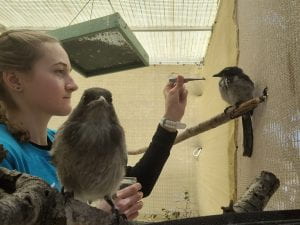Brita Stites, Sophmore Biology major, shares about their internship at he SPCA Wildlife Center in Salinas, CA.
 “My name is Brita Stites. I am a sophomore Biology major interning at the SPCA Wildlife Center in Salinas, California. Although every day is different depending on the animals currently in our care, the animals brought in by community members, and the rescue calls we must respond to, I will describe what a typical work day looks like.
“My name is Brita Stites. I am a sophomore Biology major interning at the SPCA Wildlife Center in Salinas, California. Although every day is different depending on the animals currently in our care, the animals brought in by community members, and the rescue calls we must respond to, I will describe what a typical work day looks like.
Generally, I start off my shift by prepping the animals’ food plates for that night and the next morning. Each species has an individualized plate recipe which consists of varying amounts of fruits, vegetables, protein, fish, pet food, etc. based upon their diet. I must cut the food into bite sized pieces based upon the size of the animal and gut the fish, mice, and chicks.
Throughout the shift, I respond to the baby bird timers – timers which go off at set times, indicating that a certain baby/juvenile bird needs to be fed. Depending on the behavior of the bird, it will either be tong fed (putting mealworms in its mouth when it gapes) or force fed (if the bird does not gape). Each time these birds are fed, we fill out paperwork indicating the amount each bird ate as well as their response to the feeding. Every interaction we have with an animal is marked down with any relevant information, the time, and our initials – in case there are any questions about the animal or our treatment. This information is all added to an online database which tracks the treatment and life of every patient that is placed under our care. During my shift, I will also pull up the medications for each animal, which will be administered later that night, as well as, assist in handling patients as staff members treat them.
Closing down the center is where most of my work lies as it takes several hours to do. Each intern and staff member takes a room (such as the nursery, one of the wards, the isolation room, etc.) and fulfills the tasks for that room. These tasks consist of administering medications, handing out the overnight food plates to the animals, and providing any other treatments, depending upon the patients’ needs. Typically, I do the nursery room which is where all the baby and juvenile mammals are kept. Along with medications and food plates, many of the animals in this room need to be fed formulas as they are not old enough to eat solid food. These animals are first stimulated and then given formula in the appropriate manner – with baby raccoons being bottle fed, squirrels and chipmunks being syringe fed, and opossums being fed via a tube inserted down their throats to the stomach. Once all of the animals are cared for, we finish closing down by taking out all the trash, cleaning the dishes, filing paperwork away, and turning off the lights.”